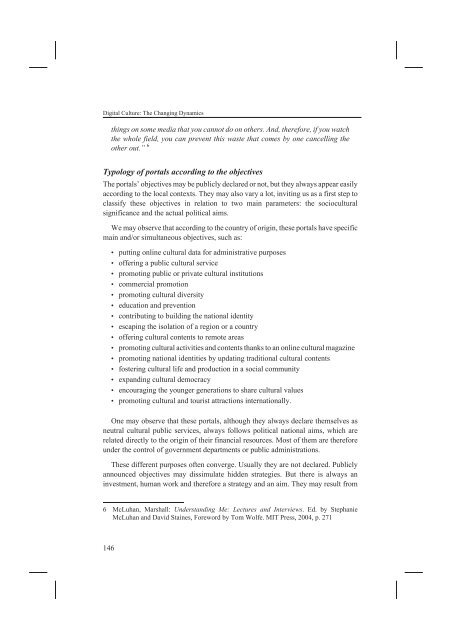D:\Documents and Settings\Ana\My Documents\Biserka-knjiga ...
D:\Documents and Settings\Ana\My Documents\Biserka-knjiga ...
D:\Documents and Settings\Ana\My Documents\Biserka-knjiga ...
Create successful ePaper yourself
Turn your PDF publications into a flip-book with our unique Google optimized e-Paper software.
Digital Culture: The Changing Dynamics<br />
things on some media that you cannot do on others. And, therefore, if you watch<br />
the whole field, you can prevent this waste that comes by one cancelling the<br />
other out.” 6<br />
Typology of portals according to the objectives<br />
The portals’ objectives may be publicly declared or not, but they always appear easily<br />
according to the local contexts. They may also vary a lot, inviting us as a first step to<br />
classify these objectives in relation to two main parameters: the sociocultural<br />
significance <strong>and</strong> the actual political aims.<br />
We may observe that according to the country of origin, these portals have specific<br />
main <strong>and</strong>/or simultaneous objectives, such as:<br />
• putting online cultural data for administrative purposes<br />
• offering a public cultural service<br />
• promoting public or private cultural institutions<br />
• commercial promotion<br />
• promoting cultural diversity<br />
• education <strong>and</strong> prevention<br />
• contributing to building the national identity<br />
• escaping the isolation of a region or a country<br />
• offering cultural contents to remote areas<br />
• promoting cultural activities <strong>and</strong> contents thanks to an online cultural magazine<br />
• promoting national identities by updating traditional cultural contents<br />
• fostering cultural life <strong>and</strong> production in a social community<br />
• exp<strong>and</strong>ing cultural democracy<br />
• encouraging the younger generations to share cultural values<br />
• promoting cultural <strong>and</strong> tourist attractions internationally.<br />
One may observe that these portals, although they always declare themselves as<br />
neutral cultural public services, always follows political national aims, which are<br />
related directly to the origin of their financial resources. Most of them are therefore<br />
under the control of government departments or public administrations.<br />
These different purposes often converge. Usually they are not declared. Publicly<br />
announced objectives may dissimulate hidden strategies. But there is always an<br />
investment, human work <strong>and</strong> therefore a strategy <strong>and</strong> an aim. They may result from<br />
6 McLuhan, Marshall: Underst<strong>and</strong>ing Me: Lectures <strong>and</strong> Interviews. Ed. by Stephanie<br />
McLuhan <strong>and</strong> David Staines, Foreword by Tom Wolfe. MIT Press, 2004, p. 271<br />
146



